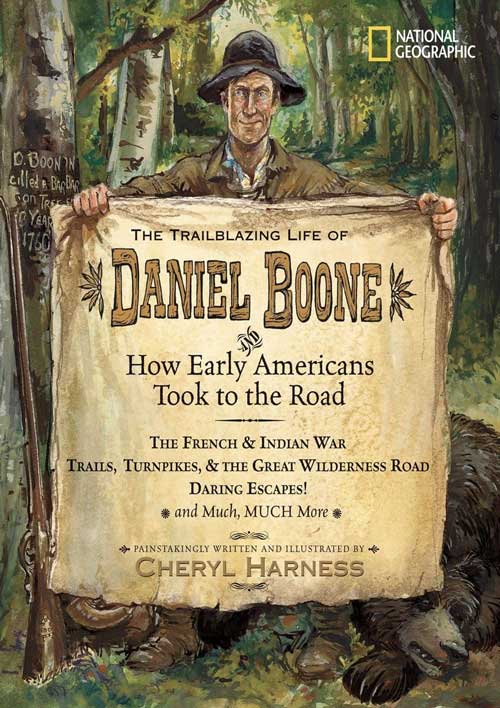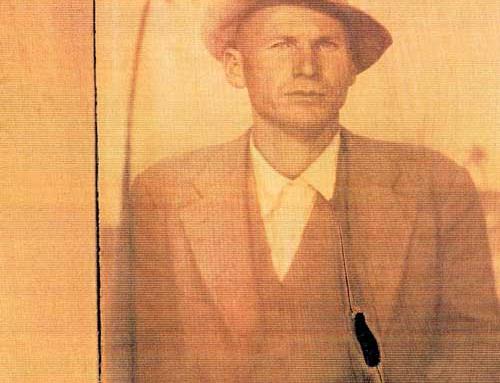This beautiful 144-page National Geographic hardcover book was painstakingly written and illustrated by Cheryl Harness for children aged 10-14 in grades 5-9.
 Daniel Boone’s story is every young adventurer’s fantasy: A childhood in Pennsylvania spent hunting on lands shared with native Americans; a coming of age fighting in the French and Indian War; and the fulfillment of a life’s dream with the blazing of the Wilderness Road across the Appalachian Mountains and the settling of Boonesboro in Kentucky. Add to this the rescue of his daughter from the Shawnee warriors, and young readers are quickly involved in the exciting and irresistible story of a Kentucky hero.
Daniel Boone’s story is every young adventurer’s fantasy: A childhood in Pennsylvania spent hunting on lands shared with native Americans; a coming of age fighting in the French and Indian War; and the fulfillment of a life’s dream with the blazing of the Wilderness Road across the Appalachian Mountains and the settling of Boonesboro in Kentucky. Add to this the rescue of his daughter from the Shawnee warriors, and young readers are quickly involved in the exciting and irresistible story of a Kentucky hero.
Cheryl Harness combines lively storytelling with vividly detailed illustrations to transport readers back to an exciting time in American history. During Daniel Boone’s 86-year life, America is transformed into a revolutionary republic, trails morph into roads and highways, and Americans discover new ways to travel – by canal and by steam-powered boats and trains. Readers journey through these historical milestones in America’s great westward expansion with the aid of a timeline running along each page, more than 200 illustrations, maps, sidebars, primary-source quotations, and resource lists. The amazing, true story of Daniel Boone will lead young readers into an era of expansive change and unforgettable adventure.
America’s quintessential frontiersman was born November 2, 1734, in Berks County, Pennsylvania, the son of Quaker pioneers Squire and Sarah (Morgan) Boone. When he was twelve or thirteen, his father gave him his first gun, with which he provided game for the family table.
Family problems resulted in his father’s expulsion from the Society of Friends. Squire Boone then moved his family from Pennsylvania to the Yadkin Valley of North Carolina, arriving in 1751 or 1752, where young Daniel married Rebecca Bryan. They settled on Sugar Tree Creek and lived there for ten years.
In the fall of 1767, Boone—like many other white explorers before him—penetrated the Kentucky wilderness on a hunting expedition. On May 1, 1769, a party of six left the Yadkin for the western wilderness.
In 1773 Boone reexplored Kentucky with a small group of men and resolved to attempt a settlement. Two weeks later, a few of the group who had been sent to procure more flour were attacked in their sleep by a band of Indians. Most of the group were killed outright, but two, including Boone’s oldest son, Jamie, were tortured to death.
Subsequently, Richard Henderson employed Boone to organize a crew of thirty axmen to cut a suitable road into the territory. Known as Boone’s Trace, it extended through the Cumberland Gap to the newly founded Fort Boone—now Boonesboro—on the Kentucky River.
Daniel Boone died on September 26, 1820, and was buried, as he had requested, in Marysville Cemetery at Defiance, Missouri, next to his wife, Rebecca. Twenty-five years later his remains were removed to Kentucky. It was not until 1862, however, that a monument was erected over the graves.
This book would be an excellent addition to home and school libraries and a great resource for children who are being home schooled. It is available from the Jesse Stuart Foundation at 4440 13th Street in Ashland. For more information, call 606-326-1667 or email jsf@jsfbooks.com,.
By James M. Gifford, Ph.D.
JSF CEO & Senior Editor
This beautiful 144-page National Geographic hardcover book was painstakingly written and illustrated by Cheryl Harness for children aged 10-14 in grades 5-9.
Daniel Boone’s story is every young adventurer’s fantasy: A childhood in Pennsylvania spent hunting on lands shared with native Americans; a coming of age fighting in the French and Indian War; and the fulfillment of a life’s dream with the blazing of the Wilderness Road across the Appalachian Mountains and the settling of Boonesboro in Kentucky. Add to this the rescue of his daughter from the Shawnee warriors, and young readers are quickly involved in the exciting and irresistible story of a Kentucky hero.

Cheryl Harness combines lively storytelling with vividly detailed illustrations to transport readers back to an exciting time in American history. During Daniel Boone’s 86-year life, America is transformed into a revolutionary republic, trails morph into roads and highways, and Americans discover new ways to travel – by canal and by steam-powered boats and trains. Readers journey through these historical milestones in America’s great westward expansion with the aid of a timeline running along each page, more than 200 illustrations, maps, sidebars, primary-source quotations, and resource lists. The amazing, true story of Daniel Boone will lead young readers into an era of expansive change and unforgettable adventure.
America’s quintessential frontiersman was born November 2, 1734, in Berks County, Pennsylvania, the son of Quaker pioneers Squire and Sarah (Morgan) Boone. When he was twelve or thirteen, his father gave him his first gun, with which he provided game for the family table.
Family problems resulted in his father’s expulsion from the Society of Friends. Squire Boone then moved his family from Pennsylvania to the Yadkin Valley of North Carolina, arriving in 1751 or 1752, where young Daniel married Rebecca Bryan. They settled on Sugar Tree Creek and lived there for ten years.
In the fall of 1767, Boone—like many other white explorers before him—penetrated the Kentucky wilderness on a hunting expedition. On May 1, 1769, a party of six left the Yadkin for the western wilderness.
In 1773 Boone reexplored Kentucky with a small group of men and resolved to attempt a settlement. Two weeks later, a few of the group who had been sent to procure more flour were attacked in their sleep by a band of Indians. Most of the group were killed outright, but two, including Boone’s oldest son, Jamie, were tortured to death.
Subsequently, Richard Henderson employed Boone to organize a crew of thirty axmen to cut a suitable road into the territory. Known as Boone’s Trace, it extended through the Cumberland Gap to the newly founded Fort Boone—now Boonesboro—on the Kentucky River.
Daniel Boone died on September 26, 1820, and was buried, as he had requested, in Marysville Cemetery at Defiance, Missouri, next to his wife, Rebecca. Twenty-five years later his remains were removed to Kentucky. It was not until 1862, however, that a monument was erected over the graves.
This book would be an excellent addition to home and school libraries and a great resource for children who are being home schooled. It is available from the Jesse Stuart Foundation at 4440 13th Street in Ashland. For more information, call 606-326-1667 or email jsf@jsfbooks.com,.
By James M. Gifford, Ph.D.
JSF CEO & Senior Editor



